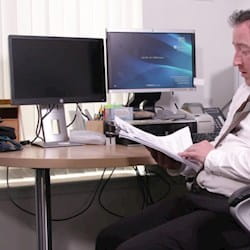IT CAME out of the blue. He stood up and pushed his chair over and declared: “I am not leaving this room until you give me my prescription.”
He was blocking my exit to the door and suddenly I felt very vulnerable. How did I get myself into this situation, and more importantly how could I get myself out?
This scenario will be familiar to many of the UK’s GPs. A BMA survey of 3,000 doctors in 2003 found violence at work was a problem for more than half of respondents, with more than a third having experienced workplace violence in the last year. This applied to hospital doctors and GPs, with the majority of GP incidents taking place in the consulting room or waiting area and involving either a patient known to them or a member of the patient’s family.
Managing Mr Angry
One of the most enjoyable and challenging aspects of general practice is the variety of people and medical problems that come through your door. As a new GP, you will be developing your clinical knowledge and communication skills in order to manage each new scenario that presents itself. It is vital to take time early in your training to consider your strategy for managing Mr or Mrs Angry who, if not skilfully handled, can transform into Mr or Mrs Violent.
Understanding the anger/assault cycle is a good place to start. Professor Glynis Breakwell identifies five phases in the transition from anger to violence in her 1997 book Coping with Aggressive Behaviour:
Trigger -> Escalation -> Crisis -> Recovery -> Post crisis depression
Patients’ anger can be triggered by a variety of events and in most cases these triggers are completely unrelated to the individual doctor. Triggers include:
- Problems with the surgery: a delay in getting an appointment or a prescription; not being able to see the GP of their choice or a long wait.
- Perceived medical failings: a belief that their illness or concerns have not been taken seriously or they have not received the treatment they feel entitled to.
- Guilt: feelings arising from actions or behaviour, or with regard to a sick relative.
- Grief: patients may be grieving either due to bereavement or perhaps they have been given a significant diagnosis.
- Problems at home: financial worries, social or psychological problems and relationship difficulties.
- Underlying medical conditions can predispose patients to a short fuse, anxiety or a psychiatric illness, or drug or alcohol dependence.
- Poor communication skills: a doctor appearing uninterested and dismissive, being abrupt and rude.
Rule number one is – do not react to the anger personally. The patient may express their dissatisfaction to you verbally (for example: “I have been waiting for 20 minutes to see you”) or non-verbally through their body language: arms folded, pursed lips, facial expressions. Understanding what can trigger a patient’s anger will help you react better.
Escalation
How you choose to respond can determine whether the anger escalates or is defused. So first of all, recognise that the patient is upset. A good response to the remark above would be: “I’m really sorry to have kept you waiting; 20 minutes is a long time.” This acknowledges that the patient is upset and that 20 minutes is a long time to wait, as well as offering an apology.
Acknowledge, agree, apologise: this type of response makes it difficult for the patient to continue to be angry, and effectively disarms them. If the doctor follows this up with some active listening the situation should be resolved.
Similarly, don’t ignore aggressive cues in body language. In this scenario the doctor could say: “You seem to be upset about something, is there anything bothering you?” If, however, the doctor ignores the patient’s comment and body language, or chooses to respond defensively (for example, by saying: “Well I can’t help that; it’s not my fault the computer is playing up”), this is more likely to escalate the patient’s frustration and anger.
Indications that the patient’s anger is escalating can be verbal, with the patient making threatening remarks, repeating themselves, shouting or swearing. Non-verbal signs can be loss of eye contact, sweating, pacing the floor, pointing or adopting an aggressive posture. It is important to recognise this escalation because there is still an opportunity to defuse the anger at this stage.
Remember: do not react personally. Instead think: “Why is the patient angry and what can I do to help them sort this out?” Acknowledge the behaviour the patient is exhibiting and describe it to them, for example: “I can see from the way you are shouting that you are very upset. Can you tell me what is upsetting you?”
Speak in an even tone and do not shout. Maintain normal eye contact and adopt a non-aggressive pose. Use active listening techniques like nodding and repetition and summarising with paralinguistic phrases ‘uh huh’ and ‘mmmh’, all of which convey to the patient that their feelings are important to you and you are taking the concerns seriously. Express empathy, concern and support for how they are feeling and apologise for any upset.
Once the patient is calmer you can discuss how you can help. It is important not to just give the patient whatever they want just because they are upset. Present the patient with realistic achievable options and come to a shared, agreed plan. As in all good consultations you should check the patient’s understanding of what you have agreed and fulfil your side of the bargain. At the end of this you may feel emotionally exhausted and it is important to recognise this and deal with your emotions before the next patient.
Crisis
Not all situations can be defused. Sometimes the warning signs are missed and the situation will escalate to crisis. This is when Mr Angry turns into Mr Violent. Rule number two is – get out and get help. Your safety is paramount and it is vital to ensure that in your consulting room you have an uninterrupted pathway to the exit. Make sure there is no furniture blocking the way to the door and, ideally, the patient’s seat shouldn’t impede your exit. Check the layout of your consulting room in advance with this in mind.
Most consulting rooms have a panic button so check where it is and find out what happens if you press it. The practice should have a protocol for what to do if a doctor presses the panic button, so be familiar with it.
Recovery phase
Even after the crisis or escalation phase has passed you are still at risk as the patient’s anger can quickly spark again, so watch for signs of further escalation. Most people are not quick to calm down. The recovery phase usually lasts around 45 minutes but it can be double that after a serious outburst.
Next is the post-crisis phase which is one of resting and recovering from the high state of arousal that the body has just experienced. The ability to think clearly begins to return and the patient may feel guilty about what has happened, which may lead to feelings of shame and depression.
A case in point
So let’s look again at the opening case of the patient demanding a prescription. This man was promised by one of the GP partners, Dr X, that he would be given a prescription for Viagra following an appointment to discuss the matter. The patient made an appointment but was booked in with the GP trainee, Dr T, without being told. This is the first trigger of his anger.
Once the consultation gets underway, Dr T is not confident that the patient meets the criteria for a prescription on the NHS. He turns his back to the patient to search the internet for guidelines. He doesn’t notice the patient’s facial expression and body language indicate he is getting annoyed. Dr T finally finds the guidelines and asks some very intimate questions which make the patient uncomfortable. His embarrassment makes him even more angry. Once Dr T is sure of his facts, he tells the patient that he doesn’t qualify for an NHS prescription of Viagra. Their discussion becomes heated and the patient shouts repeatedly that Dr X “said I could get it”.
Dr T responds by holding up the NHS guidelines on Viagra prescribing to justify his argument. The patient loses his temper and pushes over his chair. Dr T’s exit is blocked but he manages to get out and finds another GP who resolves the situation.
If you find yourself in a similarly difficult situation, then bear in mind some of the techniques mentioned above and hopefully your consultation will end on a more positive note.
Dr Susan Gibson-Smith is a medico-legal adviser at MDDUS
This page was correct at the time of publication. Any guidance is intended as general guidance for members only. If you are a member and need specific advice relating to your own circumstances, please contact one of our advisers.
Read more from this issue of Insight Primary

Save this article
Save this article to a list of favourite articles which members can access in their account.
Save to library


